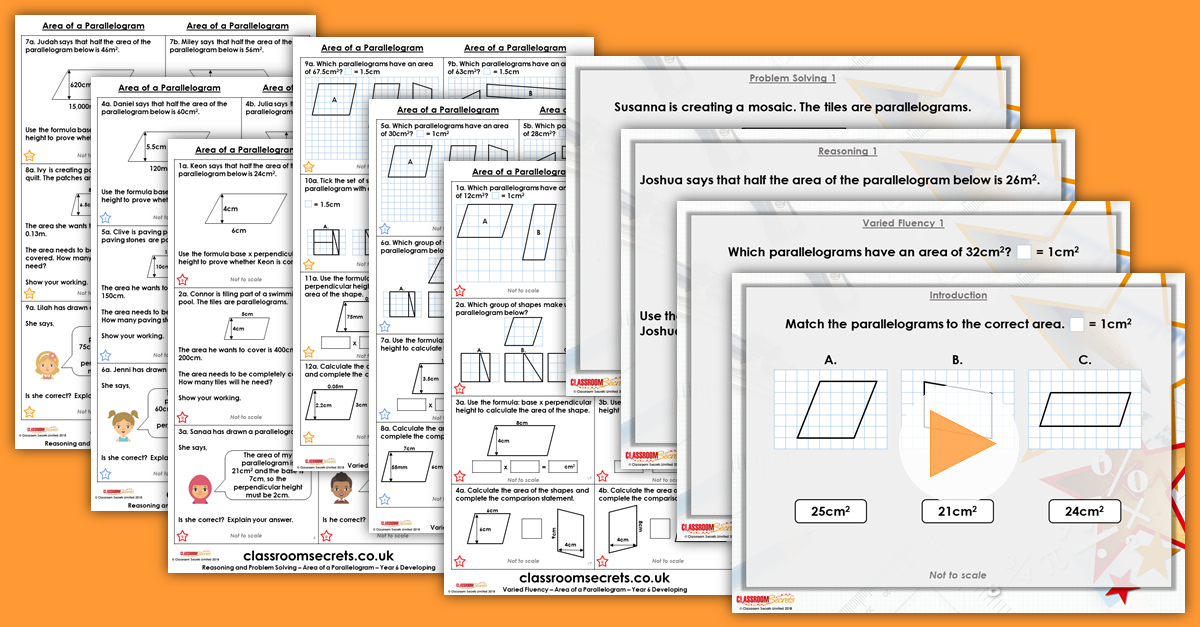Area of a Parallelogram Year 6 Perimeter Area and Volume Resource Pack
Step 6: Area of a Parallelogram Year 6 Spring Block 5 Resources
Area of a Parallelogram Year 6 Resource Pack includes a teaching PowerPoint and differentiated varied fluency and reasoning and problem solving resources for Spring Block 5.
Not a member? Sign up here.
What's included in the pack?
This pack includes:
- Area of a Parallelogram Year 6 Teaching PowerPoint.
- Area of a Parallelogram Year 6 Varied Fluency with answers.
- Area of a Parallelogram Year 6 Reasoning and Problem Solving with answers.
National Curriculum Objectives
Mathematics Year 6: (6M7b) Calculate the area of parallelograms and triangles
Mathematics Year 6: (6M7c) Recognise when it is possible to use formulae for the area of shapes
Differentiation For Year 6 Area of a Parallelogram:
Varied Fluency
Developing Questions to support finding the area of parallelograms using the formula: base x perpendicular height. Whole numbers only.
Expected Questions to support finding the area of parallelograms using the formula: base x perpendicular height. Includes some conversions (mm to cm) and some decimals (halves only). Children to select the base and perpendicular height from given measurements.
Greater Depth Questions to support finding the area of parallelograms using the formula:
base x perpendicular height. Includes some conversions (mm to cm, cm to m and mm to m) and some decimals (halves and tenths). Children to select the base and perpendicular height from given measurements.
Reasoning and Problem Solving
Questions 1, 4 and 7 (Reasoning)
Developing Use knowledge of area to explain whether the given area of a parallelogram is correct. Use of the formula: base x perpendicular height. Whole numbers only.
Expected Use knowledge of area to explain whether the given area of a parallelogram is correct. Use of the formula: base x perpendicular height. Includes some conversions (mm to cm) and some decimals (halves only). Children to select the base and perpendicular height from given measurements.
Greater Depth Use knowledge of area to explain whether the given area of a parallelogram is correct. Use of the formula: base x perpendicular height. Includes some conversions (mm to cm, cm to m and mm to m) and some decimals (halves and tenths). Children to select the base and perpendicular height from given measurements.
Questions 2, 5 and 8 (Problem Solving)
Developing Find the number of parallelograms needed to cover a given area. Differentiation as described for Question 1.
Expected Find the number of parallelograms needed to cover a given area. Differentiation as described for Question 1.
Greater Depth Find the number of parallelograms needed to cover a given area. Differentiation as described for Question 1.
Questions 3, 6 and 9 (Reasoning)
Developing Explain whether the statement is correct. Differentiation as described for Question 1.
Expected Explain whether the statement is correct. Differentiation as described for Question 1.
Greater Depth Explain whether the statement is correct. Differentiation as described for Question 1.
This resource is available to download with a Premium subscription.








